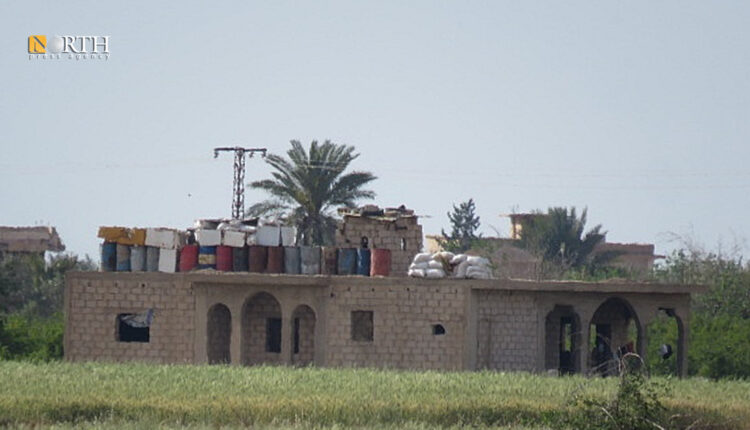
QAMISHLI, Syria (North Press) – The U.S. Central Command (CENTCOM) said their forces targeted more than 85 targets “with numerous aircraft to include long-range bombers flown from United States. The airstrikes employed more than 125 precision munitions.”
According to statement, the targeted facilities included command and control operations centers, intelligence centers, rockets and missiles, drone storages, and logistics and munitions’ supply chain facilities of Iranian-backed militias that facilitated attacks on U.S. and Global Coalition troops.
The U.S. airstrikes in Deir ez-Zor Governorate, eastern Syria, came in response to the killing of American soldiers at Tower 22 in Jordan, and resulted in 20 casualties among the Iran-backed militias.
The airstrikes were distributed as follows: in the town of Abu Kamal, two airstrikes targeted the Hajana area, a major stronghold for Iranian-backed militia; two airstrikes targeted two posts of Regiment 47 in the village of al-Heri, and another airstrike targeted a communications post in the al-Sinaa neighborhood.
An airstrike hit a surveillance and communications post in the al-Hizam area, and three airstrikes targeted the Sikak border crossing in Abu Kamal.
In the town of al-Mayadin, two airstrikes targeted the outskirts of a prison and a military camp in the al-Haydariya area. Two other airstrikes hit weapon depots in the Shabli neighborhood, and two strikes struck weapon depots and a military camp near the shrine of Ain Ali.
Also in al-Mayadin, an airstrike targeted the headquarters of Liwa Abu al-Fadhal al-Abbas near the Bal’oum Roundabout, which is a coordination and operations room affiliated with the Lebanese Hezbollah. Additionally, a communications post in the vicinity of al-Rahba Citadel was targeted, and another airstrike targeted a monitoring post in the vicinity of the grain silos in the area.
The U.S. targeted al-Temo neighborhood in al-Mayadin with three airstrikes, which is considered a major stronghold for militias backed by Iran and Hezbollah. An airstrike targeted a communications post in the vicinity of the electricity company, and another strike targeted a weapons depot in the al-Hamdaniya area.
A communications post at Deir ez-Zor airport was targeted by two airstrikes. Additionally, an airstrike targeted a communications post and a military camp in Regiment 137 in Deir ez-Zor. Two airstrikes targeted a wireless communications post in Jabal al-Ommal, as well as a weapons depot in al-Ommal neighborhood.
A U.S. airstrike targeted the Liwa Fatemiyoun headquarters at the Faculty of Education in Deir ez-Zor city, and two airstrike targeted a warehouse for weapons and drones and a guard post in the town of Harabesh, adjacent to the city.
In the Bor Saeed Street, an airstrike targeted a guard post and another one targeted a post affiliated with the Quds Force in the vicinity of the Automated Bakery. Two airstrikes targeted the Iranian Kitchen, a restaurant for Iranian-backed militias, and an adjacent weapons warehouse.
In the village of Ayyash in the north of Deir ez-Zor city, three airstrikes targeted a warehouse for weapons, drones, and a joint military camp with the Syrian government forces. An airstrike targeted a hideout in the village of Jaffra, and another post in the Hawija Sakr neighborhood, as well as a post in the town of al-Tebni.
Of the casualties, North Press obtained the names of sixteen individuals, all of whom are Iranian-backed militants killed in Deir ez-Zor, eastern Syria.
The airstrikes on the al-Rahba Citadel killed Ali Al-Karawi, who is related to the officer in charge of the Popular Mobilization Forces in Regiment 40 of the Iraqi Hezbollah in Kirkuk. Additionally, Hussein al-Zaidi, a relative of a leader named Shabal al-Zaidi, was also killed near the military crossing in the area.
An exclusive source told North Press that the airstrikes that targeted a weapons warehouse in Ayyash contained Iranian-modified medium-range Katyusha missiles.
The source pointed out that an Iranian officer from the Quds Force named Muhammad Karimi, also known as Hajj Rafat, was also killed.
A U.S. airstrike targeted a military post in Abu Kamal near the Syrian-Iraqi border, which contained modern drones intended to target the al-Omar oil field and Conoco gas field, both are U.S. bases. It resulted in the killing of four members of the al-Baqir Brigade, according to the source.
Three members of the Harakat al-Nujaba, an Iran-backed militia in Iraq, were killed: Kazem Saif al-Din al-Zahri, Ameer Hassan Sudani, and Karar Sadiq al-Rashidi.
The United States launched an airstrike on a position in al-Tamou neighborhood in al-Mayadin, which housed advanced drones brought from central Syria along with launching pads and medium-range missiles. These weapons were intended to target the U.S. base in the town of Shaddadi, northeastern Syria.
The source said that three Afghan leaders from the Iran-backed Liwa Fatemiyoun militia were killed: 36-year-old Muqtada Awla, 42-year-old Ahmad Haji Muhammad Khan Shah, and Muloy Matiullah. In addition, three Pakistani militants of the Iran-backed Liwa Zainabiyoun militia were also killed: 40-year-old Hassan Furqan Iftikhar, 35-year-old Sayed Raza Anas, and 42-year-old Saif Khuzaima al-Din Qutb al-Din.
The Syrian Ministry of Defense claimed, in a statement, that the U.S. airstrikes killed both civilians and military personnel near the Syrian-Iraqi border, while the U.S. maintains that it targeted Iran’s Islamic Revolutionary Guard Corps (IRGC) Quds Force.
